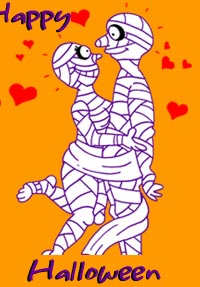万圣节是西方传统节日。万圣节前夜,当夜幕降临,孩子们穿上五颜六色的化妆服,戴上千奇百怪的面具。有的披上漆黑长衫,骑着“魔帚”,扮作女巫;有的裹上白床单装鬼;有的戴上画有骷髅旗的帽子扮成海盗……
Next to Christmas, Halloween is the most commercialized celebration in the United States and Canada. This ancient festival originated far from North America however, and centuries before the first European set foot on the continent.
The ancient Druids 督伊德教(古代高卢人与不列颠人的一种宗教)的教徒 who inhabited what we now call Great Britain placed great importance on the passing of one season to the next, holding "Fire Festivals" which were celebrated1 for three days (two days on either side of the day itself). 
One of these festivals was called Samhain (pronounced Sha-Von) and it took place on October 31 through to November 1. During this period, it was believed that the boundaries between our world and the world of the dead were weakened, allowing spirits of the recently dead to cross over and possess the living.
In order to make themselves and their homes less inviting2 to these wayward spirits, the ancient Celts(凯尔特人)would douse3 (插入水中, 把弄熄, 弄湿)all their fires. There was also a secondary purpose to this, after extinguishing all their fires, they would re-light them from a common source, the Druidic fire that was kept burning at Usinach, in the Middle of Ireland.
Samhain was considered to be a gateway4 not only from the land of the dead to the land of the living, but also between Summer and Fall/Winter. For the Druids, this was the last gasp5 (喘息, 气喘)of summer (it was also the Celtic New Year), so therefore they made sure it went out with a bang before they had to button down (把...弄清楚)for the winter ahead.
They would dress up in bizarre costumes and parade through their villages causing destruction in order to scare off any recently departed souls who might be prowling (巡游)for bodies to inhabit, in addition to burning animals and other offerings to the Druidic deities6(神, 神性). It is also a popular belief that they would burn people who they believed to be possessed7, but this has largely been debunked8 (揭穿, 拆穿假面具, 暴露)as myth.
This yearly festival was adopted by the Roman invaders9, who helped to propagate (传播, 宣传)it throughout the rest of the world (and at that time, the Roman Empire was the world). The word "Halloween" itself actually comes from a contraction10 of All Hallows Eve, or All Saint's Day (November 1), which is a Catholic day of observance in honor of saints.
This tradition was later brought to the North American continent by Irish immigrants who were escaping the Potato Famine in their homeland. In addition to the festival itself, the immigrants brought several customs with them, including one of the symbols most commonly associated with Halloween -- the Jack11 'O Lantern.
According to Irish folklore12, there once lived a man named Jack who was known for being a drunk and a prankster(顽皮的人, 爱开玩笑的人). One night Jack tricked the devil into climbing a tree, and quickly carved an image of a cross on the trunk, trapping the devil. Jack then made him promise that, in exchange for letting him out of the tree, the Devil would never tempt13 him to sin again. He reluctantly agreed, but was able to exact his revenge upon Jack's death. Because of his mischievous14 ways in life, Jack was barred from entering heaven and because of his earlier trick, he was also barred from hell. So he was doomed15 to wander the earth until the end of time, with only a single ember(灰烬, 余烬) (carried in a hollowed out turnip16.[植]芜箐, 芜箐甘蓝) to warm him and light his way.
In Ireland, they originally also used turnips17 for their "Jack Lanterns", but upon arriving in the new world, they discovered that pumpkins18 were abundant and easier to carve out.
 收听单词发音
收听单词发音 



